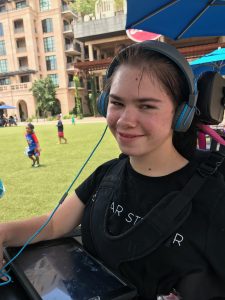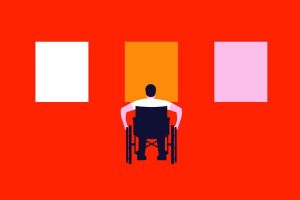Technology in a museum is not a new thing. Virtual Van Gogh, smart phones to enhance exhibits or screens that let you step into the exhibit and be a part of it. Interaction is becoming more and more of a step many museums are using to draw a technologically advanced generation into these spaces. But there is another group who can benefit from the use of technology in museums.
Let’s rethink technology for a minute. Can it be used to help those whose abilities may be differing in some areas? Assistive technologies can and should be brought into museums. Many museum have a device that gives explanations of the exhibit for people to hear, which is a start, but it is only one sense and visiting a museum should be so much more. For example, the “Eye See” is a laser helmet that can “see” items and describe them to the person wearing it. Or, there is another item called a “Brain Port” that allows the visually impaired person to wear a pair of glasses with a mouth piece attached that allows the “vision” from the glasses to be turned into pixels on the tongue that allows the user to “see” the object with their mouth.
Even just simple iPads can bring accessibilities to the museum that were not once there. In my personal experience, I have seen what iPads can do for people in an educational realm. They have allowed people with dyslexia to help with reading, people with impaired motor-skills for communication and audible books and even elderly being able to read with adjustable font. With grants to enhance the lives of people with disabilites , even the smallest of museums are able to accommodate everyone to their exhibits.

Some may believe technology does not go with museums because it is not traditional in the museum sense. But lets take a few steps back to think about who the museum is for. Museums should be for everyone. One can not simply say that a museum is not for people with disabilities. Museums have an obligation to provide for the public. Not just the literate. Not just the wealthy. Not just one select group of people.
On the conservation side, I understand the museum may face other issues. Many museums are in historic buildings, which are usually not wheelchair or other disability accessible. The museum is aware a certain group of people are excluded from the museum however keeping the integrity of the historic building is something the museum must consider. They can provide a statement that says it is not accessible.
So what is the next step?
This is a tough question that I do not know how to answer nor do others. I do not believe there is one right answer. I do believe that even just thinking about accessibility, from space in exhibits to going through the front door, is the first step to rethink technology in museums. Technology doesn’t have to be just for the up and coming generations, it is for everyone. Although there are many more ideas of privilege to think about, this is one step closer to decolonizing and rethinking the accessibility of museums.



Super cool blog Shine! As I was reading it I found myself reminiscing about areas of assistance I’ve seen when I’ve visited museums. When you mentioned the “Brain Port” it reminded me of a project I did at San Antonio College on a system called the Tongue Drive System. Its kind of the same concept as the Brain Port but in reverse and used to communicating and function in day to day life. I wonder if there is any connection or correlation between the two
https://www.youtube.com/watch?v=KZHBNYd-eWs
Hallelujah, Shine! It’s a real shame that the differently abled have to fight just to be considered in the museum and public space conversation. As future Public Historians, it’s our job to consider the needs of our public beyond just entertainment or conservation, but in terms of accessibility. I really do hope to see a change in how public buildings are handled in terms of accessibility, not just for the physically disabled, but for those with minds that work differently than ours.